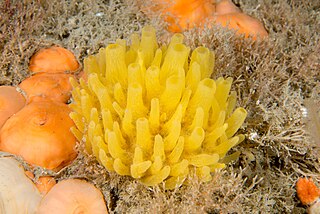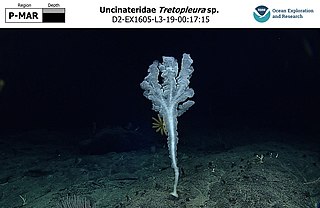
Polymastia is a genus of sea sponges containing about 30 species. These are small to large encrusting or dome-shaped sponges with a smooth surface having many teat-shaped projections (papillae). In areas of strong wave action, this genus does not grow the teat structures, but instead grows in a corrugated form.

Halichondriidae is a family of sea sponges belonging to the order Suberitida. These sponges have a skeleton consisting of dense bundles of spicules occurring in a more or less random pattern.

Plakinidae is a family of marine sponges. It is composed of seven genera:

Chondrilla is a genus of sea sponges belonging to the family Chondrillidae.

Craniella is a genus of marine sponges in the family Tetillidae.

Euplectellidae is a family of glass sponges (Hexactinellids) belonging to the order Lyssacinosa, first represented in the Ordovician fossil record, substantially older than molecular estimates of the clade's age.

Rossellidae is a family of glass sponges belonging to the order Lyssacinosa. The family has a cosmopolitan distribution and is found at a large range of depths.

Caulophacus is a genus of glass sponges belonging to the subfamily Lanuginellinae.
Acanthascus is a genus of sponges in the family Rossellidae. Species include:

Mycale is a genus of demosponge with 240 recognised species in 11 subgenera. It has been a large genus with multiple subdivisions since it was first described in 1867.
Sceptrulophora is an order of hexactinellid sponges, commonly known as Glass sponges, characterized by sceptrule spicules, that is, "microscleric monactinal triaxonic spicules that include clavules with terminel umbels or smooth heads." Species of the order Sceptrulophora have existed since the Jurassic period, and still flourish today. While there is ongoing debate about the organization of various taxa in Sceptrulophora, the monophyly of the taxon Sceptrulophora is supported by the presence of sceptrules in most of the extant species, and has recently been further supported by DNA sequencing.

Farreidae is a family of glass sponges in the order Sceptrulophora.

Farrea is a genus of glass sponges in the family Farreidae.

Euretinae is a subfamily of glass sponges in the family Euretidae.

Aspidoscopulia is a genus of glass sponge in the family Farreidae.

Uncinateridae is a family of glass sponges in the order Sceptrulophora.
Claviscopulia is a genus of glass sponge in the family Farreidae.
Diapleuridae is a family of five extinct species of marine glass sponges found in the Caribbean Sea, Florida Straits, Banda Sea, and US Virgin Islands. A sixth species–Diapleura hatoni–is postulated to have existed around the same time as the other five, but there is limited research on it. Diapleuridae is part of class Hexactinellida and order Lyssacinosida. These sponges lived during the Middle Epoch of the Eocene and were filter feeders that were attached to the benthos by a basal disc. The oldest recorded fossil of a species of Diapluridae is from 47.8 million years ago, with the most recent fossil dated 41.3 million years ago.
Rossella antarctica is a relatively small species of glass sponge. It is widely distributed in the southern hemisphere, particularly in the Antarctic and sub-Antarctic regions.















